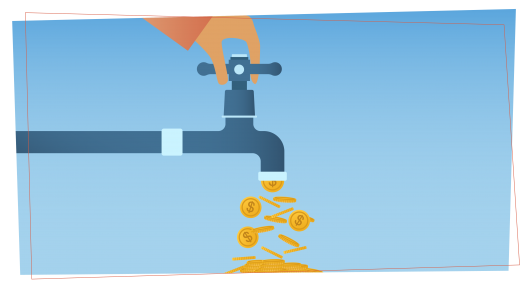Startup Success: Fundraising and Cash Flow Advice from Very Good Security
Cash Flow Basics
Any startup needs to remember that cash flow trumps growth. In 2017, at least 70% of startups failed to get funding. It wasn’t because they weren’t growing, but rather because they could not maintain positive cash flow.
Thriving small businesses and fintech startups use cash flow to their advantage. We spoke with Colin Gerber, Senior Director of Revenue Operations and Strategy at Very Good Security (VGS), to find out more about how you can balance cash flow management with growth expectations and create feasible sales goals.
VGS provides compliance and data security as a service. As a fintech startup, VGS makes data security and compliance a streamlined effort for small businesses and enterprise companies alike. Their unique approach to compliance saves companies up to 70% of compliance costs.
Colin gave us an inside look at how VGS handles cash flow management.
Align investments with long-term goals
When it comes to early-growth companies, the team must be cash conscious if they want to accurately align their funding with achieving long-term stability.
"As an early-stage company, we are cash-conscious since we are raising money,” says Colin. “At this point, startups need investments upfront.”
Early-stage companies need upfront investments in the short term to build a stable workforce and achieve long-term growth. In the beginning, it’s common for startups to rapidly grow their team to handle client needs and drive revenue. Startups in this early stage cycle should see spikes in hiring that correlate with more sales, usually above industry average benchmarks. But this short-term growth can quickly peter out.
"A key indicator to look at is your payback period. If you are scaling sustainability, you should see your payback period decreasing. For example, VGS is currently paying back investments at 20 months and will soon close in on the industry standard of 12 months."
Startups need to invest in headcount, resources, and other necessary frameworks to prepare for the long-term sales cycles. While sales and hiring spikes should decrease over time as the business aligns with the industry benchmarks, client lifetime value should increase as you get more repeat customers.
"A key indicator to look at is your payback period. If you are scaling sustainability, you should see your payback period decreasing. For example, VGS is currently paying back investments at 20 months and will soon close in on the industry standard of 12 months."
Of course, your timeline might be different if you need to pivot or find another market to sell to. It will also depend on the size of your clients. Selling to mid-market commercial businesses will generate faster sales cycles. But enterprise clients can easily take up half a year to close a deal, and they typically request more resources.
Ideally, you’ll want to balance these two types of clients to optimize your positive cash flow and sustain long-term growth.
“It’s important to keep raising the bar to service larger and larger clients,” says Colin. “You want to scale your organizations for 1:1 growth. Try to get a flywheel effect so that you can get more revenue from every new head as your team grows.”
Balance expenses
Next, you’ll want to look at your expenses and align budgets appropriately.
This can mean regularly reviewing tools, your hiring process, and whether you are accounting for taxes and other expenses.
“If we negotiate with external parties, we always are cash-flow conscious. Instead of annual upfront, we make quarterly contracts,” says Colin. “We are always watching our runway and balancing the inflow-outflow.”
It’s also essential to have thorough cash flow models. You’ll want to go in-depth in reviewing your budget and expenditures. But you always want to look at how you are building revenue. You’ll want to analyze your customers and how much you make from each sale. You can then connect this information with specific product lines and segments to fine-tune your data.
After all of this, you’ll want to work backward to account for your sales and marketing teams and assign applicable quotas.
Determine your pricing
Pricing is another major concern, and it largely depends on your product type. But it can often help to diversify your pricing set up depending on your services.
For example, VGS offers a subscription service for its data Vault and compliance services. The team analyzed their costs concerning the required AWS hosting, engineer headcount, and maintenance expenses to price this subscription appropriately.
Non-recurring costs—such as third-party audits or penetration tests—require specific quotes since the headcount increases.
However, in both cases, VGS ensures that its pricing adheres to industry benchmarks. This keeps them competitive without undercutting the industry or their services.
Translate cash flow forecasting to practical sales goals
Another key for startups is linking cash flow forecasts to realistic goals for their sales team.
“For early-stage startups, forecasting is often aspirational,” says Colin. “You need to look at KPIs that can inform your headcount.”
This includes working on productivity assumptions. If you can determine your team’s productivity level, the approximate number of bookings, and customer segmentation outlook, you can get a better idea about what’s feasible from a sales standpoint.
You want to be able to connect cash flow with relevant goals. That way, you can forecast accurately without setting unachievable expectations.
Remember the secret to startup success: Focus
It’s often tempting to want to do everything at once. And while it’s good to experiment and go to market, you don’t want to grow too quickly. Growing too fast can drain your positive cash flow and shake the foundations of your business.
“It’s all about focus. If you know where you are winning, then double down. Don’t go in too many directions. Concentrate on core offering,” advised Colin.
At the same time, as you deal with our enterprise customers, you’ll be requested to offer more custom builds and delegate more resources towards projects. This will result in stretching yourself too thin, and you’ll soon find it impossible to grow.
“It’s all about focus. If you know where you are winning, then double down. Don’t go in too many directions. Concentrate on core offering,” advised Colin.
Is your cash flow working for you?
For both fintech startups and small businesses, having firm control of your cash flow is critical for success. Cash flow monitoring and forecasting can help you determine pricing, growth direction, and keep investors happy.
Cash flow projections, detailed reports, and intuitive visualization are great ways to support your accounting team and foster growth while helping you steer clear of negative cash flow. Try out Pulse free for 30 days and take control of your business.


